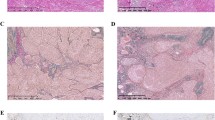Abstract
Purpose
Interstitial growth (IG), which is defined as tumor cells continuously growing into the alveolar septa at the tumor periphery, was originally reported as a growth pattern of metastatic sarcoma of the lung. On the other hand, IG in the primary lung cancers has not been well described. This study aimed to examine clinicopathological features of primary lung cancer that harbors IG.
Methods
A total of 2558 primary lung cancers which were resected from 2003 to 2012 in our hospital were examined for IG. We compared clinicopathological data and prognoses between patients with IG+ and IG− specimens.
Results
Thirty-three cases out of 2558 (1.3 %) had IG components. IG was significantly more associated with positive smoking history, advanced pathological stage, presence of vascular invasion and pleural invasion. Thirty-three IG+ cases include nine pleomorphic carcinoma, nine squamous cell carcinoma and eight adenocarcinoma. Interestingly, nine (24 %) out of 38 pleomorphic carcinoma specimens had IG components, which was a higher rate than any other histological subtypes. The IG+ cancers had significantly shorter overall and recurrence-free survival than did the IG− cancers.
Conclusions
We firstly reported on IG in various types of primary lung cancer. IG appears to be a sign of an aggressive lung cancer phenotype, mainly found in pleomorphic carcinoma.




Similar content being viewed by others
References
Bodendorf MO, Haas V, Laberke HG, Blumenstock G, Wex P, Graeter T (2009) Prognostic value and therapeutic consequences of vascular invasion in non-small cell lung carcinoma. Lung Cancer 64:71–78
Funai K, Yokose T, Ishii G, Araki K, Yoshida J, Nishimura M, Nagai K, Nishiwaki Y, Ochiai A (2003) Clinicopathologic characteristics of peripheral squamous cell carcinoma of the lung. Am J Surg Pathol 27:978–984
Gabor S, Renner H, Popper H, Anegg U, Sankin O, Matzi V, Lindenmann J, Smolle Juther FM (2004) Invasion of blood vessels as significant prognostic factor in radically resected T1-3N0M0 non-small-cell lung cancer. Eur J Cardiothorac Surg 25:439–442
Kessler R, Gasser B, Massard G, Roeslin N, Meyer P, Wihlm JM, Morand G (1996) Blood vessel invasion is a major prognostic factor in resected non-small cell lung cancer. Ann Thorac Surg 62:1489–1493
Maeda R, Yoshida J, Ishii G, Hishida T, Nishimura M, Nagai K (2010) Prognostic impact of intratumoral vascular invasion in non-small cell lung cancer patients. Thorax 65:1092–1098
Miyoshi K, Moriyama S, Kunitomo T, Nawa S (2009) Prognostic impact of intratumoral vessel invasion in completely resected pathologic stage I non-small cell lung cancer. J Thorac Cardiovasc Surg 137:429–434
Mochizuki T, Ishii G, Nagai K, Yoshida J, Nishimura M, Mizuno T, Yokose T, Suzuki K, Ochiai A (2008) Pleomorphic carcinoma of the lung: clinicopathologic characteristics of 70 cases. Am J Surg Pathol 32:1727–1735
Noguchi M, Morikawa A, Kawasaki M, Matsuno Y, Yamada T, Hirohashi S, Kondo H, Shimosato Y (1995) Small adenocarcinoma of the lung. Histologic characteristics and prognosis. Cancer 75:2844–2852
Poncelet AJ, Cornet J, Coulon C, Collard P, Noirhomme P, Weynand B (2008) Intra-tumoral vascular or perineural invasion as prognostic factors for long-term survival in early stage non-small cell lung carcinoma. Eur J Cardiothorac Surg 33:799–804
Rigau V, Molina TJ, Chaffaud C, Huchon G, Audouin J, Chevret S, Bréchot JM (2002) Blood vessel invasion in resected non small cell lungcarcinomas is predictive of metastatic occurrence. Lung Cancer 38:169–176
Shimada Y, Ishii G, Hishida T, Yoshida J, Nishimura M, Nagai K (2010) Extratumoral vascular invasion is a significant prognostic indicator and a predicting factor of distant metastasis in non-small cell lung cancer. J Thorac Oncol 5:970–975
Sobin LH, Fleming ID, TNM Classification of Malignant Tumors, fifth edition (1997) Union Internationale Contre le Cancer and the American Joint Committee on Cancer. Cancer 80:1803–1804
Travis WD, Brambilla E, Burke AP, Marx A, Nicholson AG (2015) WHO Classification of tumours of the Lung, Pleura, Thymus and Heart. Fourth edition
Watanabe Y, Yokose T, Sakuma Y, Hasegawa C, Saito H, Yamada K, Ito H, Tsuboi M, Nakayama H, Kameda Y (2011) Alveolar space filling ratio as a favorable prognostic factor in small peripheral squamous cell carcinoma of the lung. Lung Cancer 73:217–221
Welter S, Grabellus F, Schmid KW, Stamatis G, Tötsch M (2011) Growth patterns of lung metastases from sarcomas. Virchows Arch 459:213–219
Welter S, Grabellus F, Bauer S, Schuler M, Eberhardt W, Tötsch M, Stamatis G (2012) Growth patterns of lung metastases from sarcoma: prognostic and surgical implications from histology. Interact Cardiovasc Thorac Surg 15:612–617
Yoshizawa A, Motoi N, Riely GJ, Sima CS, Gerald WL, Kris MG, Park BJ, Rusch VW, Travis WD (2011) Impact of proposed IASLC/ATS/ERS classification of lung adenocarcinoma: prognostic subgroups and implications for further revision of staging based on analysis of 514 stage I cases. Mod Pathol 24:653–664
Yousem SA (2009) Peripheral squamous cell carcinoma of lung: patterns of growth with particular focus on airspace filling. Hum Pathol 40:861–867
Author information
Authors and Affiliations
Corresponding author
Ethics declarations
Conflict of interest
Shigeki S declares that he has no conflict of interest. Keiju A declares that he has no conflict of interest. Tomoyuki H declares that he has no conflict of interest. Junji Y declares that he has no conflict of interest. Takeshi K declares that he has no conflict of interest. Chisako Y declares that she has no conflict of interest. Masahiro T declares that he has no conflict of interest. Genichiro I declares that he has no conflict of interest.
Ethical approval
All procedures performed in studies involving human participants were in accordance with the ethical standards of the institutional and/or national research committee and with the 1964 Helsinki Declaration and its later amendments or comparable ethical standards.
Informed consent
Informed consent was obtained from all individual participants included in the study.
Electronic supplementary material
Below is the link to the electronic supplementary material.
Rights and permissions
About this article
Cite this article
Suzuki, S., Aokage, K., Hishida, T. et al. Interstitial growth as an aggressive growth pattern in primary lung cancer. J Cancer Res Clin Oncol 142, 1591–1598 (2016). https://doi.org/10.1007/s00432-016-2168-6
Received:
Accepted:
Published:
Issue Date:
DOI: https://doi.org/10.1007/s00432-016-2168-6




